BACKGROUND
According to recent figures, in 2011, there were a total of 302 disaster events in 98 countries, which killed 29,782 people, affected about 260,00 people and caused economic losses estimated at US$ 366 billion. The Centre for Research on the Epidemiology of Disasters (CRED) indicated that the Americas ranked second in the terms of global occurrence of natural disasters with both human and economic looses.
The trend recently seen in disasters to increase in terms of occurrence and seriousness of their impacts reminds us of the challenge contained in the Hyogo Framework for Action (2005-2015) to “substantially reduce the impact of disasters and ensure that risk reduction is a key component of development policies and programmes”.
In 2005, shortly after the earthquake and tsunami that hit Asia, more than 168 Governments pledged to implement the five strategic goals of the Hyogo Framework for Action: i) Ensure that disaster risk reduction is a national and a local priority; (ii) Identify disaster risks and take action; (iii) Use knowledge, innovation and education to build a culture of safety and resilience; (iv) Reduce underlying risk; factors; and (v) Strengthen disaster preparedness for effective response.
Similarly, the Ibero-American Summits and the Rio Group Summits, as well as the meetings held by Latin American and Caribbean institutions specializing in disaster risk reduction, have issued specific mandates to implement the agreements reached in the Hyogo Framework for Action.
SELA started to analyze this topic in 2008 with the “Meeting on mechanisms to respond to emergencies resulting from natural disasters” (Mexico City, 24 and 25 September 2008). Later on, in 2009, SELA organized two seminars on “Response Mechanisms to Natural Disasters”; one to examine experiences in the Andean region and the Southern Cone (Caracas, 3 and 4 September 2009), and the other one to review experiences in Mexico, Central America and the Caribbean (Panama City, 15 and 16 October 2009). In 2010, the Permanent Secretariat conducted the “Regional Seminar on public investment and financial mechanisms, insurance and reinsurance against disasters in Latin America and the Caribbean: Recent experiences” (Mexico City, 22 and 23 November 2010).
In 2011, upon invitation of the United Nations International Strategy Disaster Reduction (ISDR), the Permanent Secretariat participated in the “II Meeting of the Regional Platform for Disaster Risk Reduction in the Americas" (14 to 17 March 2011, in Nuevo Vallarta, Nayarit, Mexico) and organized a thematic session on “Disaster Risk Reduction at the level of the Private Sector”.
In view of the importance of the private sector’s participation in disaster risk reduction and the partnerships between public and private sectors in risk management, the Permanent Secretariat of SELA and the ISDR have joined efforts to work in that area. Thus, the Permanent Secretariat organized the Regional Seminar on “Cooperation between governments and the private sector for disaster risk reduction in Latin America and the Caribbean: Focus, progress and challenges” (Panama City, 17 and 18 November 2011). This activity was conducted jointly with the ISDR and the United States Office of Foreign Disaster Assistance (USAID-OFDA). The event provided an opportunity to sign a memorandum of understanding between the Secretariat of ISDR and the Permanent Secretariat of SELA, in order to promote cooperation and coordination in the area of disaster risk reduction in Latin America and the Caribbean, with a focus on the project “Cooperation in disaster risk reduction between governments and the private sector” for the period 2011-2015.










